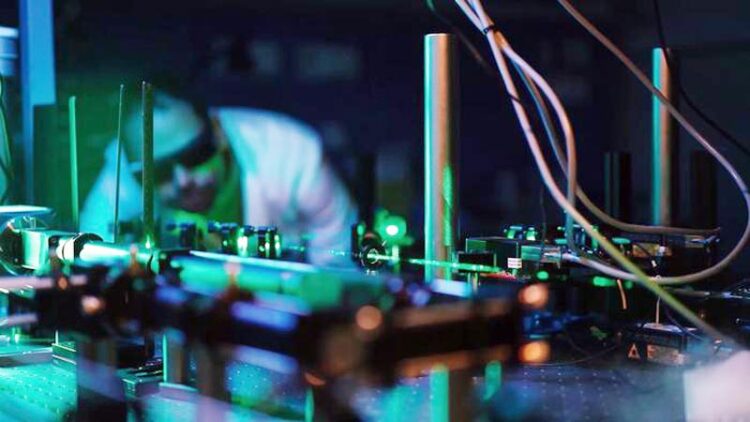Micro4PAP: a new microscope generation for in-vivo imaging of cells mechanics

Micro4PAP is a new microscope generation that uses light to study biological molecules without interfering with their nanometric structure and that allows scientists to image basic living mechanisms with sub-millisecond acquisition time
Credit: IIT-Istituto Italiano di Tecnologia
The project coordinated by Istituto Italiano di Tecnologia has been funded with 3 million euro by the European Union.
A tool that uses light to study biological molecules without interfering with their nanometric structure and that allows scientists to image basic living mechanisms with sub-millisecond acquisition time. It is the new generation microscope Micro4PAP, which is able to perform in-vivo imaging of the cell mechanical properties (rigidity, stiffness, viscosity), which is under development within the EU-funded project Micro4PAP led by the Istituto Italiano di Tecnologia (IIT-Italian Institute of Technology). The new device will be able to perform state-of-the art in vivo images of cells and tissues mechanics, facilitating the understanding of physiologic as well as pathologic processes, such as those involved, for example, in the neurodegenerative and neurodevelopmental diseases.
The project received more than 3 million euros from the European Innovation Council (EIC) under the Horizon Europe programme for research and innovation. The name “Micro4PAP” is a simplification of its technical title “IVBM-4PAP”, which stands for “In-Vivo Brillouin Microscope with application to Protein Aggregation-based Pathologies”.
Micro4PAP is coordinated by Giancarlo Ruocco and Gian Gaetano Tartaglia, Principal Investigators at IIT in Rome and in Genova. It originated from the necessity of having a new tool to investigate the mechanical properties of biological cells and tissues and acquire information to identify better disorders’ diagnosis and treatment.
Many biological processes are based on liquid-liquid and liquid-solid phase transitions, such as aggregates formation and dissolution, chromatin (the protein and nucleic acids in which genome is organized) organization and nucleus-cytoplasmic transport; alteration of these processes is linked with multiple human diseases ranging from neurodegenerative disorders to cancer.
The Micro4PAP project aims at developing a fast-scan Brillouin Microscope, a type of optical elastography which does not touch or interfere with the biological sample – thus being non-destructive, label- and contact-free method – and will be able to probe the mechanical properties, such as the viscoelastic properties of sub-cellular elements, with a 3D resolution exclusively limited to light diffraction. This novel method would be capable of sub-millisecond acquisition time, and is therefore suitable for in-vivo measurements in living cells.
Micro4PAP may be applied on the study of different pathologies, such neurodegenerative disorders, tumors, chronic and age-related diseases, thus representing a promising tool for clinical-oriented research, enhancing the capability for early disease detection, diagnosis and therapy.
Besides IIT, the Micro4PAP consortium includes research institutes, universities and companies in Italy (Università di Trento, Crestoptics S.p.A.), France (Université d’Angers) and Spain (Universidad Zaragoza).
Media Contact
Valeria delle Cave
Istituto Italiano di Tecnologia – IIT
valeria.dellecave@iit.it
Office: 0039 010 2896
All latest news from the category: Medical Engineering
The development of medical equipment, products and technical procedures is characterized by high research and development costs in a variety of fields related to the study of human medicine.
innovations-report provides informative and stimulating reports and articles on topics ranging from imaging processes, cell and tissue techniques, optical techniques, implants, orthopedic aids, clinical and medical office equipment, dialysis systems and x-ray/radiation monitoring devices to endoscopy, ultrasound, surgical techniques, and dental materials.
Newest articles

New model of neuronal circuit provides insight on eye movement
Working with week-old zebrafish larva, researchers at Weill Cornell Medicine and colleagues decoded how the connections formed by a network of neurons in the brainstem guide the fishes’ gaze. The…

Innovative protocol maps NMDA receptors in Alzheimer’s-Affected brains
Researchers from the Institute for Neurosciences (IN), a joint center of the Miguel Hernández University of Elche (UMH) and the Spanish National Research Council (CSIC), who are also part of…

New insights into sleep
…uncover key mechanisms related to cognitive function. Discovery suggests broad implications for giving brain a boost. While it’s well known that sleep enhances cognitive performance, the underlying neural mechanisms, particularly…



